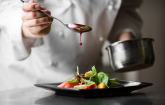Fast Casual Brands Need to Stay Distinct from QSRs
Higher price points depend on maintaining an elevated experience, cautions veteran HFA hospitality lead Steven Baker
BENTONVILLE, Ark., Oct. 10, 2024 /PRNewswire/ -- As fast casual operators increasingly turn their attention to the "fast" side of the equation, they need to stay "casual," too, advises a veteran hospitality architect from HFA Architecture + Engineering.
In an October 8 advisory column, hospitality lead Steven Baker (AIA, NCARB) notes that top fast-casual brands aim to support their digital sales channels by experimenting with the likes of digital makelines, rationalized menus, ramped-up drive-thrus and geofence-enabled curbside service.
But Baker underscores the importance of continuing to offer the hallmarks that set fast casual restaurants apart from their QSR counterparts—namely, "a better ambiance, more made-to-order options, superior food quality and a pleasing and comfortable dine-in experience.
"Push efficiency too hard and you risk becoming indistinguishable from value-based QSRs, thereby losing your ability to command higher price points," Baker observes. "Plan poorly and your attempts to better serve multiple channels can backfire, frustrating customers and crew members alike."
The architect, whose clients have included some of the nation's largest and highest-volume restaurant operators, notes that additions such as new drive-thru lanes or pickup areas typically demand some corresponding subtractions. Otherwise, costs could mushroom.
He points to a hypothetical fast-casual operator where too many dine-in customers feel frustrated as they stand in line and watch crew members make online orders. One possible solution would be a separate queue, assembly line and pickup station dedicated just for app-driven sales. But the restaurant would need to think carefully about questions such as:
- Where exactly would the new components go?
- Would the building need to be expanded, or could it just be reconfigured?
- Could the required equipment be sized to work optimally in the square footage available? How much would it cost?
- Would new utility connections be part of the mix?
- How much labor would be needed to keep the new lines humming?
Small steps can be useful, Baker observes.
At one high-volume QSR location in Maryland, moveable stanchions allowed the restaurant to roll out temporary queues and test multiple layouts. "Instead of immediately adding a double drive-thru, a fast-casual restaurant might start with more modest building and site-layout changes—for example, a pickup window with a small queue lane—that improve efficiency at lower cost," Baker notes.
As fast-casual brands seek to optimize their sites and stores, "there is no substitute for imagining in great detail where patrons and team members would go and what they would do," advises the architect, who has spearheaded hundreds of remodel and prototype-development projects geared toward redefining restaurant-industry sales channels.
For example, HFA's team will literally draw lines showing things such as:
- The likeliest pathway for a team member to deliver a pickup order to a guest or delivery driver
- Where dine-in and pickup customers are likeliest to park and how the locations of doors, drive-thru lanes and pickup windows might affect these pathways
- How different patrons will queue and where they will go after they get their orders
"The goal is to reduce or eliminate dead ends, overlapping lines, redundant steps, and illogically spaced work stations," Baker explains. "The experiential dimension is critical: Will guests need to cut in line to get to the restrooms? What will they see and hear in the dining room? Will the crew feel safe from vehicular traffic when running orders out to the parking lot?"
Efficiency-oriented imperatives will differ from brand to brand, but no matter where the needle falls between "fast" and "casual," Baker concludes, the goal should be to preserve and enhance what sets you apart from value-based QSRs. "Good fast-casual restaurants are lifestyle-oriented destinations where people are happy to pay a bit more for the experience. Make sure your customers continue to see it that way."
The full article is available at: https://www.hfa-ae.com/blog/get-fast-but-stay-casual
About HFA Architecture + Engineering: HFA is a nationwide architecture and engineering firm with offices in Bentonville, AR, Fort Worth, TX, Franklin, MA, Springfield, MO, and Mexico City. With over 30 years of experience, HFA has become a trusted partner for a diverse range of clients, providing comprehensive services that combine design innovation and project delivery excellence. The studio's portfolio includes commercial projects in retail, industrial, mixed-use/office, restaurants, healthcare, hospitality and entertainment spaces. To learn more about HFA and their work, visit https://www.hfa-ae.com/
Media Contacts: At Jaffe Communications, Elisa Krantz, (908) 789-0700, [email protected]
SOURCE HFA Architecture + Engineering

WANT YOUR COMPANY'S NEWS FEATURED ON PRNEWSWIRE.COM?
Newsrooms &
Influencers
Digital Media
Outlets
Journalists
Opted In






Share this article